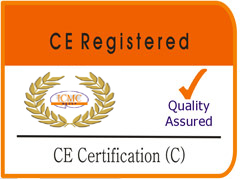CE Marking
Material for Businesses
These notes are intended to provide reference material for businesses on how to “CE mark” products.
They may help you ensure your product complies with the relevant legislation, especially if you want to sell your product overseas or use/sell imported products from overseas.
By thinking of the issues discussed in the notes in advance, you could save your company time and money, avoid doing something illegal and add the potential of selling your product in new markets.

Nobody likes regulation. However it is often necessary in order to produce fair markets in which legitimate businesses producing and selling safe products of a high standard are protected from unfair competition.
This information pack has been compiled by your local Trading Standards Department as part of a new scheme to advise your business on legislation issues.
We are there to help you at an early stage and to make your company anticipate and react to potential problems from the word go.
If your business manufacturers or imports products in the categories below, and would benefit from some more advice in the area of CE marking, why not sign up for one of our forthcoming seminars on the subject. Specialist Trading Standards Officers, as well as expert staff from the DTI, will be on hand to offer your company one to one support on how the issue of CE marking affects your company.
This advisory scheme forms part of a wider programme of activities all geared to help companies trade internationally. the other activities
1. Which businesses are affected by CE Marking?
2. Manufacturers
3. Importers
4. Distributors
5. Retailers
If you manufacture or sell products in the UK or the rest of the EU, you will have to comply with the relevant European Directive in your field to demonstrate that your products or the products you sell are ‘fit for their intended use’.
How do you demonstrate this?
The way to show you comply is to ‘CE mark’ your product. This symbol is not a quality standard or an indication that products comply with European or other standards. It is merely a tool to show buyers that your products comply to the specific requirements set out in the directive and that the relevant tests have been carried out. It acts like a passport for your products, allowing them to travel freely within an agreed area (see below). It is illegal to supply a product that does not comply and manufacturers and traders can be prosecuted if products do not carry the mark when required to.
What brought about the CE Marking Directives?
Because each country within the European Union has its own laws and regulations, it can be difficult for manufacturers to market their products in each of these countries. The New Approach Directives and the use of the CE Marking try to solve this problem because the symbol means the same thing in all the member states of the European Union.
How do you go about CE Marking your products?
The way you have to go about getting the CE Mark varies depending on what your product is. More detailed notes in this pack cover the following products:
1. Electrical Safety (1994)
2. Toys (1995)
3. Simple Pressure Vessels (mid-1993)
4. Electromagnetic Compatibility (1996)
5. Personal Protective Equipment (mid-1995)
